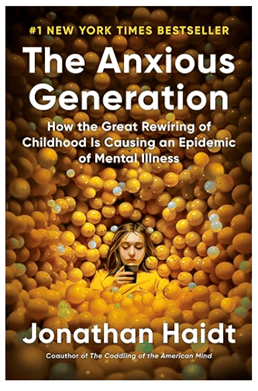By Jim Heffernan
While we were talking about the current censorship at Tillamook High School, Laura recommended the book, “The Coddling of the American Mind”. I saw that the same author had a newer book and I chose that one instead. I was changed and moved by Jonathan Haidt’s earlier book, “The Righteous Mind” so I didn’t see much risk in reading another. I really liked the book. It taught me a lot about human development and I agreed with what he had to say about a better way forward for our youth and ourselves.
Jonathan Haidt is a social psychologist and the author of four books. In his latest book, he thoroughly explores how smart phones and social media are damaging the latest generation of our youth. I think he’s spot-on about the young, and I think our phone culture is damaging all of us. When we should be relating with the real people around us, we’re stuck in our phones and a virtual world that isolates us.
The book is divided into four parts and 12 chapters. The first three parts and 8 chapters deal with the psychology of developing minds. The last part and last four chapters are what he recommends to repair the damage we are doing to our children (and ourselves).
Humans are the only mammals who have a protracted puberty stage where their brains go through an extensive brain and body re-wiring that lasts from about age 12 to age 18. When I went through mine, we were all in a constant “explore” mode. We took chances and we had no choice but to relate with real people. Smart phones and media have led most of the current generation to be in “defend” mode where virtual reality crowds out actual reality.
We worry about our youth playing in the neighborhood, but ignore the harm that an on-line presence can lead to. He proposes that phones not be allowed in schools and that parents are very careful about when our children get phones and how they use them.
Here’s are a couple of excerpts.
Gen Z became the first generation in history to go through puberty with a portal in their pockets that called them away from the people nearby and into an alternative universe that was exciting, addictive, unstable, and –as I will show—unsuitable for children and adolescents. (Page 6)
Mountain Middle School in Durango, Colorado, went phone-free back in 2012, at the start of the mental health crisis. The county around the school had among the highest teen suicide rates in Colorado when Shane Voss took over as head of school. Students were suffering from rampant cyberbullying, sleep deprivation, and constant social comparison.
Voss implemented a cell phone ban. For the entire school day, phones had to stay in backpacks, not in pockets or hands. There were clear policies and real consequences if phones were found out of the backpack during school hours. The effects were transformative. Students no longer sat silently next to each other, scrolling while waiting for home room or class to start. They talked to each other or the teacher. Voss says that when he walks into a school without a phone ban, “It’s kind of like the zombie apocalypse, and you have all these kids in the hallways not talking to each other. It’s just a very different vibe.”
The school’s academic performance improved, and after a few years it attained Colorado’s highest performance rating. An eighth grader named Henry explained the effect of the phone ban. He said that for the first half-hour of the school day his phone is still in the back of his mind, “but once class starts, then it’s just kinda out the window and I’m not really thinking about it. So it’s not a big distraction for me during school.” In other words, the phone ban ameliorates three of the four foundational harms of the phone-based childhood: attention fragmentation, social deprivation, and addiction. It reduces social comparison and the pull into the virtual world. It generates communion and community.(Page 248)
Available Cloud and Leaf Bookstore, Manzanita and Tillamook Public Library 395 Pages (88 Acknowledgments/Notes/Index) Published March 26, 2024


